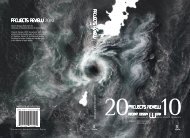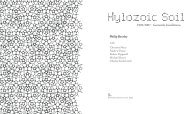The Inner Studio - Riverside Architectural Press
The Inner Studio - Riverside Architectural Press
The Inner Studio - Riverside Architectural Press
Create successful ePaper yourself
Turn your PDF publications into a flip-book with our unique Google optimized e-Paper software.
PART FOUR | INNER KNOW-HOW<br />
After producing these first images, it is often very helpful to<br />
have other people interpret the drawing because, much like in a<br />
dream, these images may have meanings that are so close to us that<br />
we can’t see them. Or we may be too urgently searching to see<br />
what’s before us. So it’s often helpful to take this new image directly<br />
to a friend or trusted colleague and ask him or her to “develop” the<br />
image by talking about it or listening as you describe it.<br />
You may wish to experiment with drawing, dragging gently or<br />
heavily. <strong>The</strong>re is always more in a drawing than we can see. At this<br />
stage, there is no reason to be limited to a drawing. Modeling our<br />
heart’s desire sometimes brings enormous advantages to the<br />
process because we are immediately involved in material and<br />
special conditions that set in motion otherwise unseen complexities.<br />
A model automatically causes you to consider the plan,<br />
section, and perhaps materiality of a project, all at the same time.<br />
For some people, working with a model is the most comprehensive<br />
and integrating vehicle for the development of a project. Finally, try<br />
not to be in a hurry.<br />
<strong>The</strong> Parti Drawing<br />
At a certain point, we need to make an initial summary of our<br />
intentions–this is commonly referred to as a parti drawing. It is not<br />
a diagram of the project, but a first embodiment of our heart’s<br />
desire in the language of design.<br />
Remember that a parti drawing gives organizational intentions<br />
to the project. <strong>The</strong> intention of this drawing is to galvanize preoccupations<br />
and perceptions. <strong>The</strong>se drawings and/or models could<br />
simply be called representations of “the big idea.” A parti drawing<br />
expresses organizational qualities, spatial ordering, and, perhaps,<br />
something of the proposed character of the project. Depending on<br />
your approach to the project, this drawing may be overtly planometric<br />
or sectional or generated by an elevation. Any or all of these<br />
may form your starting point. Seeing this drawing allows others to<br />
understand your “response” to the design problem along a spectrum<br />
of possible responses. This drawing is important because it is<br />
a generator. It will influence and guide other drawings. We suggest<br />
137





